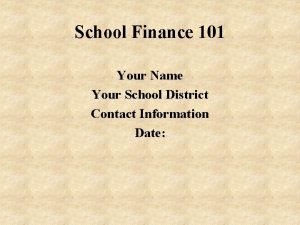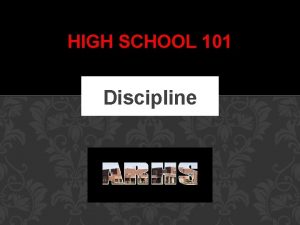WELCOME TO HIGH SCHOOL 101 WHY HIGH SCHOOL









- Slides: 9

WELCOME TO HIGH SCHOOL 101

WHY HIGH SCHOOL INFORMATION NOW? • Middle School students may earn high school credit • Earning high school credit means a transcript is starting to build • It’s never too early to start planning for the future

Graduating From High School College/Career Ready • Students will earn a Foundation High School Program Diploma with at least one endorsement • Students have five endorsements from which to select • Endorsements allow students to explore an area of interest to determine if it is a good fit for college and/or career

What are the course requirements of the Foundation High School Program with an Endorsement? • • • English – 4 credits • Biology, IPC or an advanced science, and additional advanced sciences • • Social Studies – 3 credits • English I, III, and an advanced English Math – 3 credits + advanced Math LOTE – 2 credits Credits must be in the same language • Fine Arts – 1 credit • Physical Education – 1 credit • Speech/Health Algebra I, Geometry, Algebra II and an advanced math Science – 3 credits + additional science based on endorsement US History, ½ credit government, ½ credit economics, and either world history or world geography, or a new course combining world history and world geography (to be developed) • • • . 5 credit Speech. 5 credit Health Additional six credits based on endorsement requirements

What are the five endorsement areas? • 1. STEM Science, Math, and CTE: Engineering • 2. Public Services Health science, Education, Law Enforcement, Military, Human Services • 3. Business and Industry Agriculture, Arts/AV/Communication, Business Management/Finance/Marketing, Information technology, Transportation/Distribution/Logistics • 4. Arts and Humanities World languages, social studies, and fine arts • 5. Multidisciplinary Studies Provides students the opportunity to take a variety of electives from any endorsement area

The Distinguished Level of Achievement will: • Allows students to be considered for Top 10% automatic admissions eligibility at any Texas public university with the exception of The University of Texas at Austin; Automatic admission standards for UT are established during the student’s junior year • Ensure you are a more competitive applicant at the most selective colleges and universities. What it means • The Distinguished Level of Achievement requires more math and more science than the Foundation High School Program. The Distinguished Level of Achievement requires: • • • A total of four credits in math, including Algebra II; A total of four credits in science; and Successful completion of an endorsement in your area of interest. Advantages • • Opportunity to earn an endorsement in an area of interest and possibly certifications More college and university options Better preparation for college-level coursework at community/technical colleges and universities Strong foundation to successfully complete an industry workforce credential or college degree

What is Rank? • Class ranking is based on a weighted point chart and is not reflected in the actual grade recorded for each course on the transcript. • More rigorous courses (Honors, Dual Credit, and AP) receive greater point value than academic level courses • Not all courses count towards class rank • Courses receiving up to 8 rank points include all AP courses, Dual Credit courses, Independent Study Mentorship, and transferred IB courses • Courses receiving up to 7 rank points include Honors core classes, Honors foreign language, and Honors electives • Courses receiving up to 6 rank points include all academic level core and foreign language courses

What is GPA? • GPA stands for Grade Point Average • Grade Point Averages include all courses taken for high school credit • A student’s GPA starts with the first high school credit course taken. For many, this is in middle school. • Keeping grades up makes students stronger candidates for acceptance into universities

Important Websites NBHS Counselor Website Find information regarding upcoming events Resources for students and parents PSAT/ACT information Dual Credit information NBHS College and Career Website College admissions information Financial aid information Scholarship information Career information

















